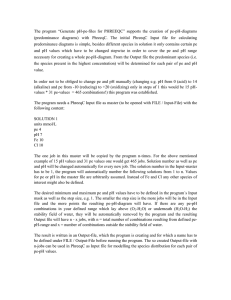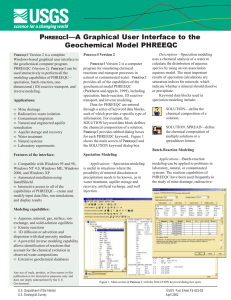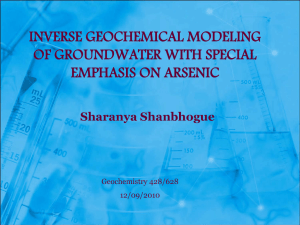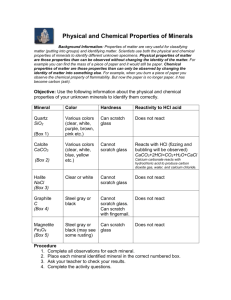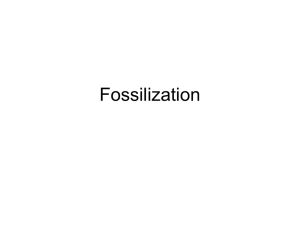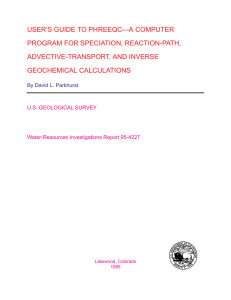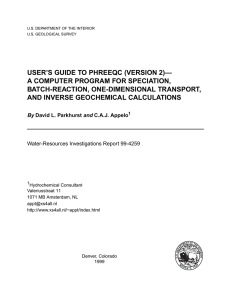Phreeqc short course Mine water workshop 2013
advertisement
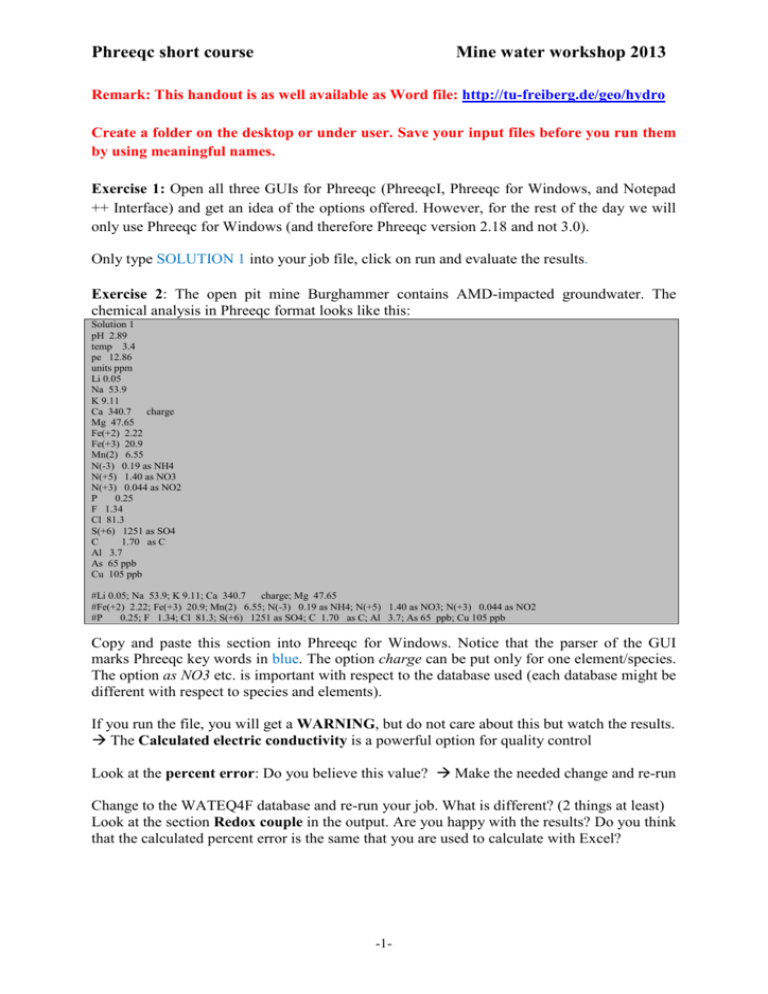
Phreeqc short course Mine water workshop 2013 Remark: This handout is as well available as Word file: http://tu-freiberg.de/geo/hydro Create a folder on the desktop or under user. Save your input files before you run them by using meaningful names. Exercise 1: Open all three GUIs for Phreeqc (PhreeqcI, Phreeqc for Windows, and Notepad ++ Interface) and get an idea of the options offered. However, for the rest of the day we will only use Phreeqc for Windows (and therefore Phreeqc version 2.18 and not 3.0). Only type SOLUTION 1 into your job file, click on run and evaluate the results. Exercise 2: The open pit mine Burghammer contains AMD-impacted groundwater. The chemical analysis in Phreeqc format looks like this: Solution 1 pH 2.89 temp 3.4 pe 12.86 units ppm Li 0.05 Na 53.9 K 9.11 Ca 340.7 charge Mg 47.65 Fe(+2) 2.22 Fe(+3) 20.9 Mn(2) 6.55 N(-3) 0.19 as NH4 N(+5) 1.40 as NO3 N(+3) 0.044 as NO2 P 0.25 F 1.34 Cl 81.3 S(+6) 1251 as SO4 C 1.70 as C Al 3.7 As 65 ppb Cu 105 ppb #Li 0.05; Na 53.9; K 9.11; Ca 340.7 charge; Mg 47.65 #Fe(+2) 2.22; Fe(+3) 20.9; Mn(2) 6.55; N(-3) 0.19 as NH4; N(+5) 1.40 as NO3; N(+3) 0.044 as NO2 #P 0.25; F 1.34; Cl 81.3; S(+6) 1251 as SO4; C 1.70 as C; Al 3.7; As 65 ppb; Cu 105 ppb Copy and paste this section into Phreeqc for Windows. Notice that the parser of the GUI marks Phreeqc key words in blue. The option charge can be put only for one element/species. The option as NO3 etc. is important with respect to the database used (each database might be different with respect to species and elements). If you run the file, you will get a WARNING, but do not care about this but watch the results. The Calculated electric conductivity is a powerful option for quality control Look at the percent error: Do you believe this value? Make the needed change and re-run Change to the WATEQ4F database and re-run your job. What is different? (2 things at least) Look at the section Redox couple in the output. Are you happy with the results? Do you think that the calculated percent error is the same that you are used to calculate with Excel? -1- Phreeqc short course Mine water workshop 2013 Now have a look at the section Species and in particular at the elements Al, As, C, Ca, Cu, F, Fe, P and S. What is remarkable? You may plot the species distribution by importing data to Excel in less than a minute. Now have a look at the section Phase: Which minerals are oversaturated? Will they precipitate? Check gypsum! Again: export this section to Excel; sorting the data by SI makes things easy and ready for plotting. Last REMARK: semicolon is equal to <carriage return> (new line) Exercise 3: Using dolomite or calcite is a common mine water treatment technique. But how can we add a mineral to a given water? One option is to use the keyword EQUILIBRIUM_PHASES. Therefore, add this keyword and Calcite 0 10 in the next line and evaluate the result. (The first zero orders SI=0; the second number stands for 10 mols of calcite per liter of water) How much Calcite is consumed to reach the CO2-calcite equilibrium (Phase assemblage) What is the final pH and sulphate concentration? Has this reaction an impact on other minerals´ SI? What is the SI of the phase CO2(g)? What does this mean? Does it matter where we put the keyword? Exercise 4: Revise your model from exercise 3 and assume that calcite is added but that additionally amorphous Al- and Fe-hydroxide will precipitate as consequence and that equilibrium with atmospheric pCO2 will establish. What will be the consequence of Al- and Fe-hydroxide precipitation? Can we model this with Phreeqc? Exercise 5: Change the temperature of the water from exercise 4 to 5, 15, 25, 35, 45, 55, 65 °C and display the result. You may do this with 7 separate jobs or using the keyword REACTION_TEMPERATURE. Use the keyword SELECTED_OUTPUT to tailor an separate output file: SELECTED_OUTPUT -file name.csv -saturation_indices Gypsum Calcite Exercise 6: Water in CCe (CO2-Calcite equilibrium)? Check the analysis of exercise 1 for its pHc. This is rather simple by adding the equilibrium_phases statement with Calcite as mineral. Compare the original pH with the pH after equilibrium with carbonate. (If you followed the advice to save jobs under meaningful names, you can answer this question without wasting CO2 ) -2-

